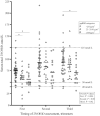Longitudinal Assessment of Vitamin D Status across Trimesters of Pregnancy
- PMID: 33830266
- PMCID: PMC8245879
- DOI: 10.1093/jn/nxab060
Longitudinal Assessment of Vitamin D Status across Trimesters of Pregnancy
Abstract
Background: The evolution of vitamin D status across pregnancy trimesters and its association with prepregnancy body mass index (ppBMI; in kg/m2) remain unclear.
Objectives: We aimed to 1) assess trimester-specific serum total 25-hydroxyvitamin D [25(OH)D] concentrations, 2) compare those concentrations between ppBMI categories, and 3) examine associations between 25(OH)D concentrations, ppBMI, and vitamin D intake.
Methods: As part of a prospective cohort study, 79 pregnant women with a mean age of 32.1 y and ppBMI of 25.7 kg/m2 were recruited in their first trimester (average 9.3 weeks of gestation). Each trimester, vitamin D intake was assessed by 3 Web-based 24-h recalls and a Web questionnaire on supplement use. Serum total 25(OH)D was measured by LC-tandem MS. Repeated-measures ANOVA was performed to assess the evolution of 25(OH)D concentrations across trimesters of pregnancy and comparisons of 25(OH)D concentrations between ppBMI categories were assessed by 1-factor ANOVAs. Stepwise regression analyses were used to identify determinants of 25(OH)D concentrations in the third trimester.
Results: Mean ± SD serum total 25(OH)D concentrations increased across trimesters, even after adjustments for ppBMI, seasonal variation, and vitamin D intake from supplements (67.5 ± 20.4, 86.5 ± 30.9, and 88.3 ± 29.0 nmol/L at mean ± SD 12.6 ± 0.8, 22.5 ± 0.8, and 33.0 ± 0.6 weeks of gestation, respectively; P < 0.0001). In the first and third trimesters, women with a ppBMI ≥30 had lower serum total 25(OH)D concentrations than women with a ppBMI <25 (P < 0.05); however, most had concentrations >40nmol/L by the second trimester. Vitamin D intake from supplements was the strongest determinant of third-trimester serum total 25(OH)D concentrations (r2 = 0.246, β = 0.51; P < 0.0001).
Conclusions: There was an increase in serum total 25(OH)D concentrations across trimesters, independent of ppBMI, seasonal variation, and vitamin D intake from supplements. Almost all women had serum total 25(OH)D concentrations over the 40- and 50-nmol/L thresholds, thus our study supports the prenatal use of a multivitamin across pregnancy.
Keywords: 25(OH)D; 25-hydroxyvitamin D; pregnancy; supplements; vitamin D; vitamin D intake; vitamin D status.
© The Author(s) 2021. Published by Oxford University Press on behalf of the American Society for Nutrition.
Figures


Similar articles
-
Higher Than Recommended Folic Acid Intakes is Associated with High Folate Status Throughout Pregnancy in a Prospective French-Canadian Cohort.J Nutr. 2023 May;153(5):1347-1358. doi: 10.1016/j.tjnut.2023.02.027. Epub 2023 Feb 26. J Nutr. 2023. PMID: 36848988
-
Vitamin D status in pregnant Indian women across trimesters and different seasons and its correlation with neonatal serum 25-hydroxyvitamin D levels.Br J Nutr. 2011 Nov;106(9):1383-9. doi: 10.1017/S000711451100170X. Epub 2011 May 31. Br J Nutr. 2011. PMID: 21736816
-
Summer Season and Recommended Vitamin D Intake Support Adequate Vitamin D Status throughout Pregnancy in Healthy Canadian Women and Their Newborns.J Nutr. 2020 Apr 1;150(4):739-746. doi: 10.1093/jn/nxz276. J Nutr. 2020. PMID: 31732740
-
Relative importance of summer sun exposure, vitamin D intake, and genes to vitamin D status in Dutch older adults: The B-PROOF study.J Steroid Biochem Mol Biol. 2016 Nov;164:168-176. doi: 10.1016/j.jsbmb.2015.08.008. Epub 2015 Aug 11. J Steroid Biochem Mol Biol. 2016. PMID: 26275945 Review.
-
Systematic review and meta-analysis of vitamin D deficiency in different pregnancy on preterm birth: Deficiency in middle pregnancy might be at risk.Medicine (Baltimore). 2021 Jun 18;100(24):e26303. doi: 10.1097/MD.0000000000026303. Medicine (Baltimore). 2021. PMID: 34128867 Free PMC article.
Cited by
-
Disparities in Vitamin D Status of Newborn Infants from a Diverse Sociodemographic Population in Montreal, Canada.J Nutr. 2022 Jan 11;152(1):255-268. doi: 10.1093/jn/nxab344. J Nutr. 2022. PMID: 34612495 Free PMC article.
-
Dietary intakes, diet quality and physical activity levels from preconception to late pregnancy: Prospective assessment of changes and adherence to recommendations.Womens Health (Lond). 2025 Jan-Dec;21:17455057251341999. doi: 10.1177/17455057251341999. Epub 2025 Jun 24. Womens Health (Lond). 2025. PMID: 40554727 Free PMC article.
-
Maternal plasma vitamin D levels across pregnancy are not associated with neonatal birthweight: findings from an Australian cohort study of low-risk pregnant women.BMC Pregnancy Childbirth. 2023 Jan 26;23(1):67. doi: 10.1186/s12884-022-05336-0. BMC Pregnancy Childbirth. 2023. PMID: 36703113 Free PMC article.
-
Effects of Climate, Sun Exposure, and Dietary Intake on Vitamin D Concentrations in Pregnant Women: A Population-Based Study.Nutrients. 2023 Feb 27;15(5):1182. doi: 10.3390/nu15051182. Nutrients. 2023. PMID: 36904183 Free PMC article.
-
Changes in vitamin D biomarkers across pregnancy and by maternal BMI: A secondary analysis of data and biospecimens from the National Children's Study.J Steroid Biochem Mol Biol. 2025 Sep;252:106791. doi: 10.1016/j.jsbmb.2025.106791. Epub 2025 May 21. J Steroid Biochem Mol Biol. 2025. PMID: 40409736
References
-
- Otten J, Hellwig J, Meyers L. Dietary Reference Intakes: the essential guide to nutrient requirements. Washington (DC): US National Academies Press; 2006.
-
- Health Canada . Prenatal nutrition guidelines for health professionals. Ottawa (Ontario): Health Canada; 2009.
-
- Dubois L, Diasparra M, Bedard B, Colapinto CK, Fontaine-Bisson B, Morisset AS, Tremblay RE, Fraser WD. Adequacy of nutritional intake from food and supplements in a cohort of pregnant women in Quebec, Canada: the 3D Cohort Study (Design, Develop, Discover). Am J Clin Nutr. 2017;106:541–8. - PubMed
Publication types
MeSH terms
Substances
Grants and funding
LinkOut - more resources
Full Text Sources
Other Literature Sources
Medical
Research Materials

